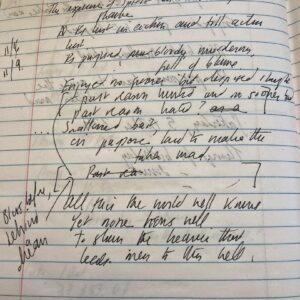Contemporary commentary on Shakespeare’s sonnets, following obvious cultural trends, privileges physical love over spiritual love and tends to focus critical attention on “pervasive bawdy innuendo” in the sonnets. To the average contemporary reader, it’s all about the sex, of course, and more importantly, it’s about transgressive sex, which these days is so much in vogue. On this reading, Shakespeare is a veritable queer hero, and the final two sonnets, some would argue of dubious authorship, are just pedestrian affirmations of a theme that appears over and over: the persistence and ultimate triumph of desire over a repressive morality. Lust is the hero of this story. But however common or oft-repeated, I don’t think it’s a true story. I think the sonnets have a different story to tell, one in which the final two sonnets provide the key to unlock the deeper meaning of the entire sequence. But we will have to acknowledge spiritual love as a genuine human possibility in order to find it.
Sonnets 153 and 154 borrow a story from an epigram by the sixth-century Byzantine poet Marianus Scholasticus. In the epigram, Love lays down to rest and entrusts his love-torch to nymphs, who take the torch and plunge it into nearby waters, expecting to put the fire out. Instead, the fire heats the water, and it becomes a hot spring with healing properties. The story itself is of tremendous interest, in particular because we find (after 152 sonnets wrestling with lust) Love himself exhausted—so exhausted that he lays down the source of his erotic power. This form of love has reached an inevitable point of fatigue: something else is wanting. But the fire won’t be extinguished. When the nymphs plunge the fire of erotic love into water, it creates a healing bath: an exhausted erotic love is transformed into something life-giving and new.
Shakespeare tells the story twice in this final couplet of sonnets, and it’s in the double-telling that a conversion narrative stretching across all 154 sonnets is definitively revealed. The speaker in Sonnet 153 is emotionally and spiritually fatigued (and possibly physically diseased) from a life in thrall to erotic love. He is tired and feels trapped in the prison of lust but doesn’t know how to escape, or what it would look like to be free. Shakespeare sets the scene in this sonnet in the language of classical mythology, naming love “Cupid” and the torch-bearing nymph the “maid of Dian’s advantage.” This is the realm of pagan love, of Eros as the foundational creative force of the universe. The “holy fire of love” in this sonnet, which lends to the bath its healing properties, upholds Eros in the way the Greeks did. But this love, erotic love, isn’t enough. The bath fails to heal:
But at my mistress’ eye love’s brand new fired, The boy for trial needs would touch my breast; I, sick withal, the help of bath desired, And thither hied, a sad distempered guest, But found no cure; the bath for my help lies Where Cupid got new fire: my mistress’ eye.
After the fire was quenched and gave rise to the healing waters, “love’s brand” sprang forth again in the eye of his mistress. It’s no real transformation. Like trick candles on a birthday cake, it flames up again just at the moment you think it’s extinguished. Sonnet 153 ends in despair. The speaker is unwilling or unable to be healed of the sickness that plagues him. I am reminded here of St. Augustine: “Lord make me chaste, but not today.”
Do we meet the same speaker, in the same story, in Sonnet 154? Still fatigued and seeking healing, he enters the architecture of the same story, but all of the details are described under a different aspect. Shakespeare forgoes the mythological “Cupid” in favor of the more general “little love-god,” and the “maid of Dian’s advantage” becomes “the fairest votary.” And she is special. Among the many nymphs who “vowed chaste life to keep” that “came tripping by,” she is the only one who takes up the fire. It’s as if she is chosen to carry that fire to the place where it can be transformed. The set-up ends with the remarkable lines: “And so the general of hot desire / Was, sleeping, by a virgin hand disarmed.” Is it a coincidence that a blessed virgin is the intermediary in this transfiguration of love? That a blessed virgin enables a new and healing love, a spiritual love which many are unable to see because they are still in thrall to Eros, like the speaker in Sonnet 153?
This re-configuration of symbolism marks the turn from an erotic to a spiritual love. Here we have left the realm of Eros, of pagan love, and entered the realm of a love that can save. Eros becomes caritas, and genuine healing becomes possible. In Sonnet 153, the torch is plunged into a “cold valley-fountain,” generating a hot spring; in 154, it is plunged into a “cool well,” creating a baptismal font.
This is a place of true healing, an authentic hope to answer the seeking over the long arc of more than 150 sonnets. But as with the rest of Shakespeare’s sonnets, the spiritual significance is easy to miss—and I would argue not just because he was writing in a time of intense Catholic persecution, but because he knows that true conversion just is this quiet, this difficult, this subtle. In Sonnet 153, the speaker makes explicit that he finds no cure; but in Sonnet 154, a different ending emerges:
This brand she quenched in a cool well by, Which from love’s fire took heat perpetual, Growing a bath and healthful remedy For men diseased; but I, my mistress’ thrall, Came there for cure, and this by that I prove: Love’s fire heats water, water cools not love.
At first pass, these lines appear to say the same thing as Sonnet 153—but in this new spiritual key, the subtle changes to the landscape make all the difference.
The grammar makes it clear. The speaker is set apart like the “fairest votary”: the first ‘but’ in the sonnet distinguishes the fairest votary from the other nymphs who pass by the little love-god without stopping to quench his erotic fire, which suggests that the second ‘but’—“but I, my mistress’ thrall”—sets the speaker apart from the other “men diseased” who don’t go to the healing well. Unlike the speaker in Sonnet 153, who “found no cure,” the speaker here explicitly states, “but I came there for cure, and…by that [cure] I prove….”
So it is here, at the baptismal waters, that the fire of love is transformed. Here, the vain attempt to “extinguish” love is transformed into something new and holy. And it is his thrall to his mistress that proves that true transformation is possible: that, baptized, love is not “cooled” but heats the waters around it, becomes a healing force itself. It is the one true joy that awaits the speaker willing to extinguish his love only to find it given back to him anew. Relieved of the enslaving mistress of lust, the speaker finds true love in the liberating thralldom to his new mistress, the Church.
Anna Key is the author of two full-length books of poetry, After Colonna: Contemporary Devotional Sonnets and Notebook of Forgetting. She is a principal creator of the Sailing Blowin’ in the Wind YouTube channel and Through the Window: A Podcast In Search of Poetic Dwelling. Her work is available through In the Wind Projects.





